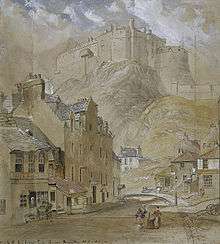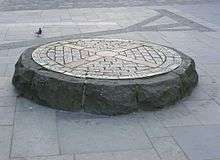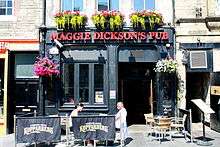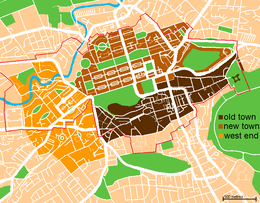Grassmarket
The Grassmarket is a historic market place and an event space in the Old Town of Edinburgh, Scotland. In relation to the rest of the city it lies in a hollow, well below surrounding ground levels.
Location
The Grassmarket is located directly below Edinburgh Castle and forms part of one of the main east-west vehicle arteries through the city centre. It adjoins the Cowgate and Candlemaker Row at the east end, the West Bow (the lower end of Victoria Street) in the north-east corner, King's Stables Road to the north west and the West Port to the west. Leading off from the south-west corner is the Vennel, on the east side of which can still be seen some of the best surviving parts of the Flodden and Telfer town walls.
The view to the north, dominated by the castle, has long been a favourite subject of painters and photographers, making it one of the iconic views of the city.
History
First mentioned in the Registrum Magni Sigilii Regum Scotorum (1363) as "the street called Newbygging [new buildings] under the castle", the Grassmarket was, from 1477, one of Edinburgh's main market places, a part of which was given over to the sale of horse and cattle (the name apparently deriving from livestock grazing in pens beyond its western end).[1]

Daniel Defoe, who visited Edinburgh in the 1720s, reports the place being used for two open air markets: the "Grass-market" and the "Horse-market". Of the West Bow at the north-east corner, considerably altered in the Victorian period, he wrote, "This street, which is called the Bow, is generally full of wholesale traders, and those very considerable dealers in iron, pitch, tar, oil, hemp, flax, linseed, painters' colours, dyers, drugs and woods, and such like heavy goods, and supplies country shopkeepers, as our wholesale dealers in England do. And here I may say, is a visible face of trade; most of them have also warehouses in Leith, where they lay up the heavier goods, and bring them hither, or sell them by patterns and samples, as they have occasion."[2]
From 1800 onwards the area became a focal point for the influx of Irish immigrants and a high number of lodging houses appeared for those unable to pay a regular rent. Community views of these immigrants were polarised by the Burke and Hare murders on Tanners Close at West Port (the west end of the Grassmarket) in 1828. From the 1840s conditions were somewhat horrendous, with up to 12 people in what would now be deemed a small double bedroom, and occupants being locked in the room overnight. Police inspections had begun in 1822 but the rules themselves caused many of he problems. A further Act of 1848 combined police surveillance with limits on occupation. In 1888 the City Public Health Department recorded seven lodging houses holding a total of an incredible 414 persons. Crombies Land at the foot of West Port held 70 people in 27 bedrooms, with no toilet provision.[3]
As a gathering point for market traders and cattle drovers, the Grassmarket was traditionally a place of taverns, hostelries and temporary lodgings, a fact still reflected in the use of some of the surrounding buildings. In the late 18th century the fly coach to London, via Dumfries and Carlisle, set out from an inn at the Cowgate Head at the eastern end of the market place.[4] In 1803 William and Dorothy Wordsworth took rooms at the White Hart Inn, where the poet Robert Burns had stayed during his last visit to Edinburgh in 1791. In her account of the visit Dorothy described it as "not noisy, and tolerably cheap".[5] In his 1961 film Greyfriars Bobby Walt Disney chose a lodging in the Grassmarket as the place where the Skye terrier's owner dies (depicting him as a shepherd hoping to be hired at the market rather than the real-life dog's owner, police night watchman John Gray).
The meat market closed in 1911 when a new municipal slaughter house at Tollcross replaced the old "shambles" in the western half of the Grassmarket (a road beyond the open market place) which joins King's Stables Road.
The association of the area with the poor and homeless only began to lessen in the 1970s: with Salvation Army hostels at both ends of the Grassmarket. Closure of the female hostel at the junction of West Port and the Grassmarket around 2000 in combination with an overall gentrification, capitalising on the streets location, began to truly change the atmosphere. Closure of the public toilets at the east end (a focal point for alcoholics) and comprehensive relandscaping in the beginning of the 21st century has transformed the character of the area.
An inscribed flagstone in the central pavement in front of the White Hart Inn indicates the spot where a bomb exploded during a Zeppelin raid on the city on the night of 2–3 April 1916. Eleven people were killed in the raid, though none at this particular spot.[6]
As a place of execution
The Grassmarket was also a traditional place of public executions.

A memorial near the site once occupied by the gibbet was created by public subscription in 1937. It commemorates over 100 Covenanters who died on the gallows between 1661 and 1688 during the period known as The Killing Time. Their names, where known, are recorded on a nearby plaque. One obdurate prisoner's refusal to escape death by swearing loyalty to the Crown prompted the snide remark by the Duke of Rothes that he had chosen to "glorify God in the Grassmarket".[7]
In 1736 the Grassmarket formed the backdrop to the Porteous Riots which ended in the lynching of a captain of the Town Guard. A plaque near the traditional execution site now marks the spot where an enraged mob brought Captain Porteous's life to a brutal end.

A popular story in Edinburgh is that of Margaret Dickson, a fishwife from Musselburgh who was hanged in the Grassmarket in 1724 for murdering her illegitimate baby shortly after birth. After the hanging, her body was taken back to Musselburgh on a cart. However, on the way there she awoke. Since, under Scots Law, her punishment had been carried out, she could not be executed for a second time for the same crime (only later were the words "until dead" added to the sentence of hanging). Her "resurrection" was also to some extent seen as divine intervention, and so she was allowed to go free.[8] In later life (and legend) she was referred to as "half-hangit Maggie". There is now a pub in the Grassmarket named after her.
In 1775, the young advocate James Boswell's first criminal client, John Reid from Peeblesshire, was hanged in the Grassmarket for sheep-stealing. Boswell, convinced of his client's innocence and citing Maggie Dickson's miraculous recovery, hatched a plan to recover Reid's corpse immediately after execution and have it resuscitated by surgeons. He was finally dissuaded from this course of action by a friend who warned him that the condemned man had become resigned to his fate and might well curse Boswell for bringing him back to life.[9]
Sir Walter Scott described his memory of the Grassmarket gibbet in his novel The Heart of Midlothian published in 1818.
The fatal day was announced to the public, by the appearance of a huge black gallows-tree towards the eastern end of the Grassmarket. This ill-omened apparition was of great height, with a scaffold surrounding it, and a double ladder placed against it, for the ascent of the unhappy criminal and the executioner. As this apparatus was always arranged before dawn, it seemed as if the gallows had grown out of the earth in the course of one night, like the production of some foul demon; and I well remember the fright with which the schoolboys, when I was one of their number, used to regard these ominous signs of deadly preparation. On the night after the execution the gallows again disappeared, and was conveyed in silence and darkness to the place where it was usually deposited, which was one of the vaults under the Parliament House, or courts of justice."[10]
Architecture
The old market area is surrounded by pubs, clubs, local retail shops, and two large Apex Hotels. Many students live in the Grassmarket, though its openness (due to the large market space) and proximity to the centre of town now tend to increase house prices.
The building dates range from 17th century to 21st century. The White Hart Inn dates from the early 18th Century and claims to be the oldest public house in Edinburgh and is said to have been visited by Robert Burns (1759–96), the Wordsworths (1803), William Burke and William Hare in the late 1820s.[11]
The City Improvement Scheme of 1868 cleared many of the slums and widened streets such as West Port, and the western group of buildings all derive from this plan. A further improvement plan in the 1920s by the City architect Ebenezer MacRae skilfully closed many of the gaps with faux Scots Baronial blocks, ironically all built as council housing.
There are several modern buildings on its southern side. Some properties were used by Heriot-Watt University, and its predecessor college, for teaching and research until the university moved fully to its new Riccarton campus (1974–92).[12] The Mountbatten Building of Heriot-Watt University was built in 1968) for the departments of electrical engineering, management and languages.[13][14] The Mountbatten building was converted and reopened as the Apex International Hotel in 1996.[15]
An example of 21st century architecture is Dance Base (2001) by Malcolm Fraser Architects, the Scottish National Centre for Dance, which runs back from a traditional frontage to a multi-level design on the slopes of the Castle rock; the design won a Civic Trust Award and Scottish Design Award in 2002.[16][17][18]
Modern developments
For most of its history the Grassmarket was one of the poorest areas of the city, associated in the nineteenth century with an influx of poor Irish and the infamous murderers Burke and Hare. Up until quite recently it was still to some extent associated with homelessness and drunkenness before its rapid gentrification as a popular tourist spot. The character of the area was reflected in a number of hostels for the homeless, including that of the Salvation Army Women's Hostel (now a backpackers hostel) which existed here until the 1980s. From then on property prices started to rise sharply.
The area is, and always has been, dominated by a series of public houses. In recent years many have become more family-friendly and include dining areas. The council has recently further encouraged these to spill over onto outside pavements, giving the place a more Continental atmosphere.
The Grassmarket was subject to a streetscape improvement scheme carried out 2009–10 at a cost of £5 million. Measures aimed at making the area more pedestrian-friendly included the extension of pavement café areas and the creation of an "events zone".
The "shadow" of a gibbet was added in dark paving on the former gallows site (next to the Covenanters' Monument) and the line of the Flodden Wall at the western end delineated by a strip of lighter paving from the Vennel on the south side to the newly created Granny's Green Steps on the north side.
References
- S Harris, The Place Names of Edinburgh, Gordon Wright Publishing, Edinburgh 1996
- D Defoe, A Tour Through The Whole Island Of Great Britain [1724–26], Penguin 1978, p. 582
- By the Three Grest Roads, aberdeen University Press
- H M Milne (ed.), Boswell's Edinburgh Journals 1767–1786, Mercat Press 2001, p. 499
- D Wordsworth, A Tour In Scotland in 1803, Mercat Press 1974, p. 243
- http://www.scotsman.com/news/night-zeppelins-brought-first-dose-of-air-raid-death-1-1336753
- R Chambers, Minor Antiquities of Edinburgh, Edinburgh 1833, p. 319
- Executions in Edinburgh 1400 to 1900 (folio, National Library)
- H M Milne (ed.), Boswell's Edinburgh Journals 1767–1786, Mercat Press 2001, pp. 136 & 156
- W Scott, The Heart of Midlothian, T C & E C Jack, Melrose edition, c. 1880, pp. 15–16
- "White Hart Inn". The Gazetteer for Scotland. University of Edinburgh and The Royal Scottish Geographical Society. Retrieved 8 May 2017.
- Taylor, Helen. "A new campus". Heriot-Watt University Heritage and Information Governance. Heriot-Watt University. Retrieved 8 May 2017.
- "Two Centuries of Learning: Your guide to Heriot-Watt University" (Pdf booklet). Heriot-Watt University. Heriot-Watt University. p. 17. Retrieved 8 May 2017.
- "Mountbatten Building, Heriot Watt University". Capital Collections. Edinburgh Libraries Museums and Galleries. Retrieved 8 May 2017.
- "Grassmarket". The Gazetteer for Scotland. School of GeoSciences, University of Edinburgh and The Royal Scottish Geographical Society. Retrieved 8 May 2017.
- "Dance Base". The Gazetteer for Scotland. School of GeoSciences, University of Edinburgh and The Royal Scottish Geographical Society. Retrieved 8 May 2017.
- "Dance Base by Malcolm Fraser Architects". Archello. Archello. Retrieved 8 May 2017.
- "Image gallery". Dance Base. Dance Base. Retrieved 8 May 2017.
.jpg)
